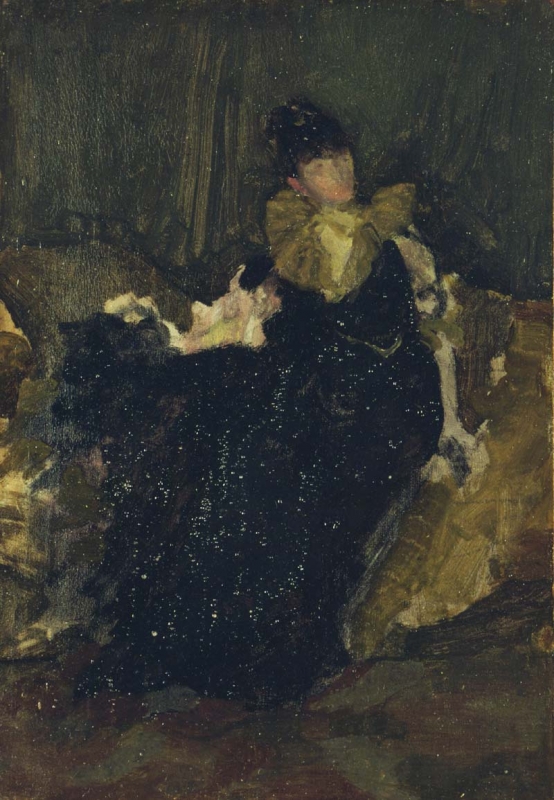Technique
The priming appears to be a thin white layer, applied with vertical brushstrokes, and there is no obvious imprimatura. 1
Under the left arm there is a horizontal line that could suggest squaring-up, and, a few strokes below this, what might be an outline for the drapery on the sofa, though the paint does not follow it. These lines look like graphite pencil. 2 The colour was painted in thinly at first. The model's right leg was originally further left and her dress was longer and more full. Another layer of colour was painted more boldly on top. The woman's face – painted with a small pointed brush – was never finished.
The bodied appearance and retained brushstrokes of paint for the background, sofa or bed, and black dress have the appearance of paint mixed with megilp, a paint modifier that facilitated both thin glazes and thick application, while providing transparency and gloss. This was made from oil (often linseed oil), lead-based driers, mastic resin, and often copal resin too, at this date. The black dress is thickly painted over the background, creating the thickest paint layer on the panel. 3 Originally the black must have set off the unusual combination of colours – gold and khaki on the sofa, reddish brown and grey on the floor – dramatically.
Conservation History
The wood panel is a single piece of timber with an auxiliary backing and framing device, both made from mahogany-type hardwood, with adhered thin 5-6 mm battens having mitred corners. 4 Stuck on the verso of this support panel is a label giving the title and address of Rosalind Birnie Philip (1873-1958). This suggests that this form of auxiliary backing was done after Whistler's death, possibly for exhibition.
The paint layer is very unstable and friable, with some paint loss, minor cracking and craquelure. The thick paint of the black dress, painted over the background, may account for the formation (in this colour alone) of numerous protrusions, some ‘topped’ to reveal the white priming. There is also some similar blistering in the ruff and hair of the model. The protrusions are likely to be lead soap aggregates (LSAs), formed naturally as paint rich in lead driers ages. This is extremely unusual in Whistler's work and might suggest he was using a different medium from usual. 5
Frame
49.5 x 41.8 x 5.6 cm.
Last updated: 7th December 2020 by Margaret






